Be My Multiple, I’ll Be Your Factor - Exercise-wise Questions and Answers For Class 5 Maths - Free PDF Download
The foundation of factors and multiples is crucial for Class 5 students as it builds their understanding of basic arithmetic operations. Factors are numbers that divide another number exactly, while multiples result from multiplying a number by an integer. Understanding these concepts helps students solve problems related to division and multiplication efficiently.
 Table of Content
Table of ContentIt's important to focus on identifying and differentiating between factors and multiples. Students should practice finding common factors and multiples, essential for more advanced math topics. This chapter provides a strong foundation for these fundamental concepts. NCERT Solutions for Class 5 Maths is curated as per the Updated CBSE Syllabus for Class 5 Maths.
Glance on Maths Chapter 6 Class 5 - Be My Multiple, I’ll Be Your Factor
This Class 5th Maths Chapter 6, Be My Multiple, I’ll Be Your Factor, simply and engagingly deals with the concept of multiples and factors for Class 5 students.
Multiples are the result of multiplying a number by an integer, and they can be seen as repeated additions of the same number. Factors are numbers that divide another number exactly without leaving a remainder.
The chapter covers common multiples shared by two or more numbers.
Students will also learn about common factors, which are numbers of two or more numbers.
This article contains chapter notes, important questions, exemplar solutions, exercises and video links for Chapter 6 - Be My Multiple, I’ll Be Your Factor, which you can download as PDFs.
In class 10th maths chapter 3, Pair of Linear Equations in Two Variables, there are three exercises (12 fully solved questions).
Access NCERT Solutions for Class 5 Maths Chapter 6 – Be My Multiple, I’ll Be Your Factor
1. The hungry cat is trying to catch Kunjan, the mouse. Kunjan is now on the 14th step, and it can jump 2 steps at a time. The cat is on the third step. She can jump 3 steps at a time. If the mouse reaches 28, it can hide in the hole. Find out whether the mouse can get away safely.
a) The steps on which the mouse jumps
Ans. The mouse jumps from the 14th step to the 16, 18, 20, 22, 24, 26, and 28th steps.
b) The steps on which the cat jumps
Ans. The cat jumps from the 3rd step to the 6, 9, 12, 15, 18, 21, 24, and 27th steps.
c) The steps on which both the cat and the mouse jump
Ans. The cat and the mouse jump on the 18th and 24th steps.
d) Can the mouse get away?
Ans. Yes, the mouse can get away.
2. Find out If the cat starts from the 5th step and jumps five steps at a time, and the mouse starts from the 8th step and jumps four steps at a time, can the mouse get away?
Ans. If the cat starts from the 5th step and jumps five steps at a time, the cat jumps from the 5th step to the 10, 15, 20, and 25th steps,
Then, the mouse starts from the 8th step and jumps four steps at a time, the mouse jumps from the 8th step to 12, 16, 20, and 24th steps.
Then, the mouse cannot get away. Cat will easily catch the mouse at the 20th step.
3. Who is Monto waiting for?
Monto cat is waiting for somebody. Do you know for whom he is waiting?
There is a trick to find out.
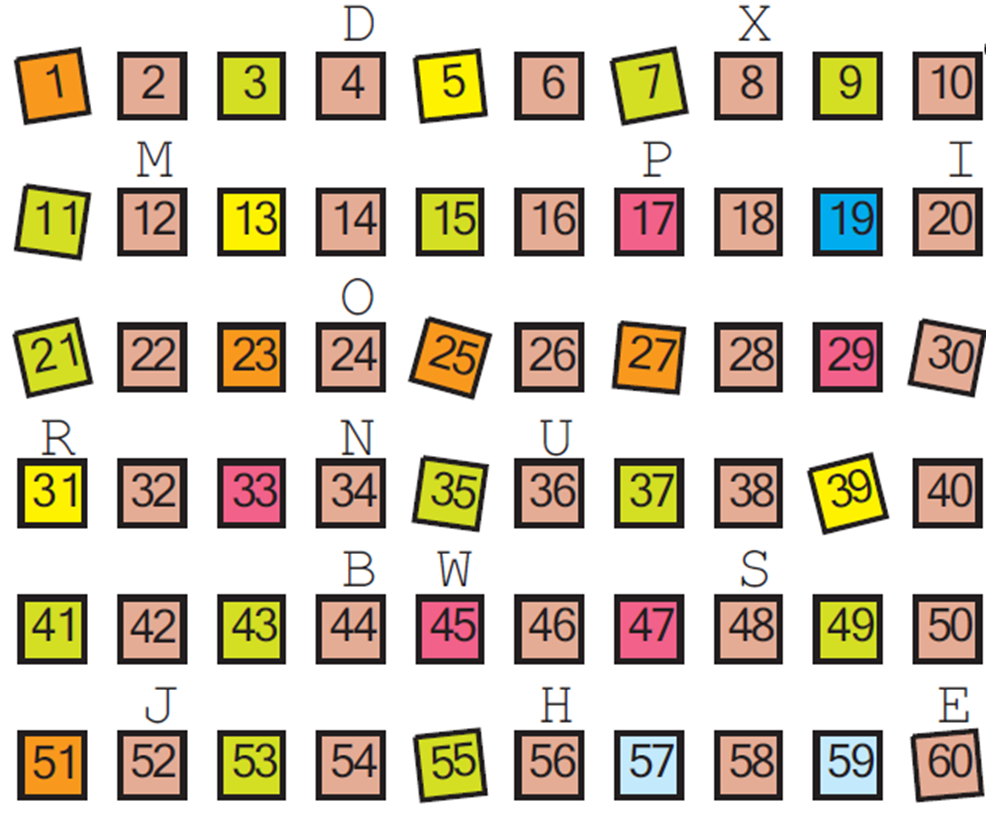
Mark with a red dot all the numbers which can be divided by 2.
Mark a yellow dot on the numbers which can be divided by 3 and a blue dot on the numbers which can be divided by 4.
Ans.
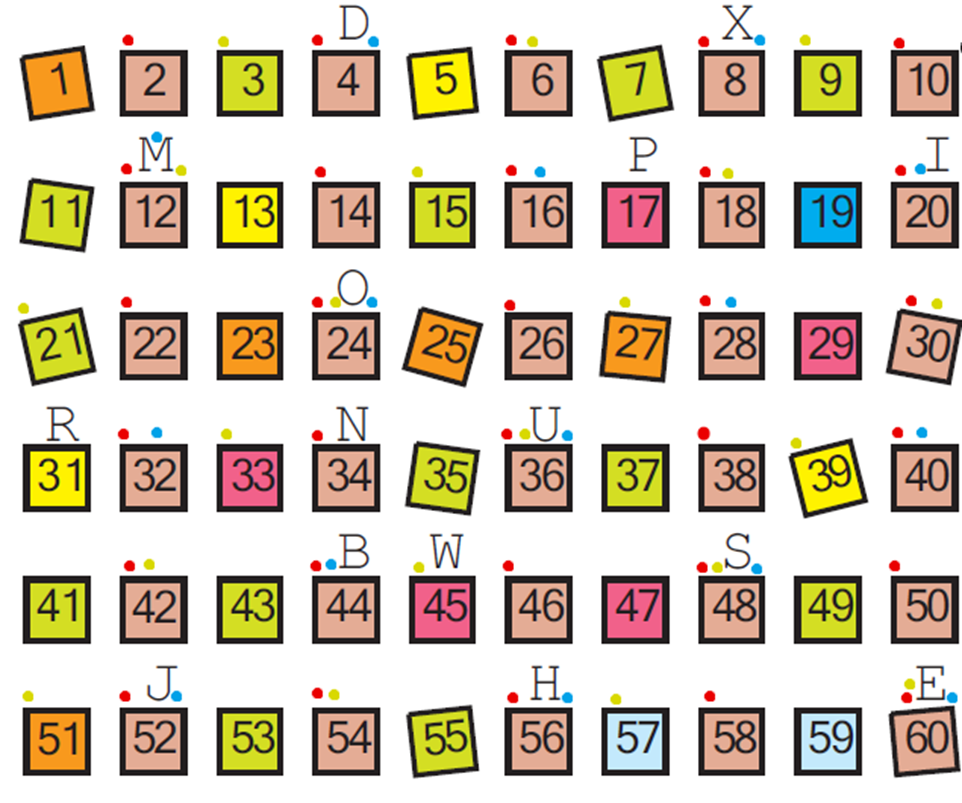
(a) Which are the boxes that have dots of all three colours?
Ans. The boxes with dots of all three colours are 12, 24, 36, 48, and 60.
(b) What are the letters on top of these boxes?
Ans. The letters on top of these boxes are M, O, U, S, and E.
(c ) Write the letters, M, O, U, S, and E, in order.
Ans. MOUSE.
4. Meow Game: To play this game, everyone stands in a circle. One player calls out ‘one’. The next player says ‘two’ and so on. A player who has to call out 3 or a number which can be divided by 3 has to say ‘Meow’ instead of the number. One who forgets to say ‘Meow’ is out of the game. The last player left is the winner.
(a) Which numbers did you replace with ‘Meow’?
Ans. The numbers which replace with ‘Meow’ and multiples of 3 are,
3, 6, 9, 12, 15, 18, 21, 24, 27, 30, 33, 36, 39, 42, 45 and so on.
5. We say these numbers are multiples of 4. Find the numbers.
Play the game by changing the number to 4. Now, which numbers did you replace with ‘Meow’? These numbers are the multiples of 4.
Ans. The numbers which replace with ‘Meow’ and multiples of 4 are,
4, 8, 12, 16, 20, 24, 28, 32, 36, 40, and so on.
(a) Write any ten multiples of 5.
Ans. Ten multiples of 5 are 5, 10, 15, 20, 25, 30, 35, 40, 45, and 50.
6. Common Multiples
(a) Think of a number. If it is a multiple of 3, write it in the red circle. If it is a multiple of 5, write it in the blue circle.

Ans. 12 and 18 are multiple of 3.
15 and 35 are multiple of 5.
Then,

(b) Some numbers are multiples of both 3 and 5. So we can say that they are both 3 and 5. Think! If you write the multiples common to 3 and 5 in the purple part, then will they still be in both the red and the blue circles?
Ans. 45 and 30 are the numbers that are multiples of both 3 and 5.
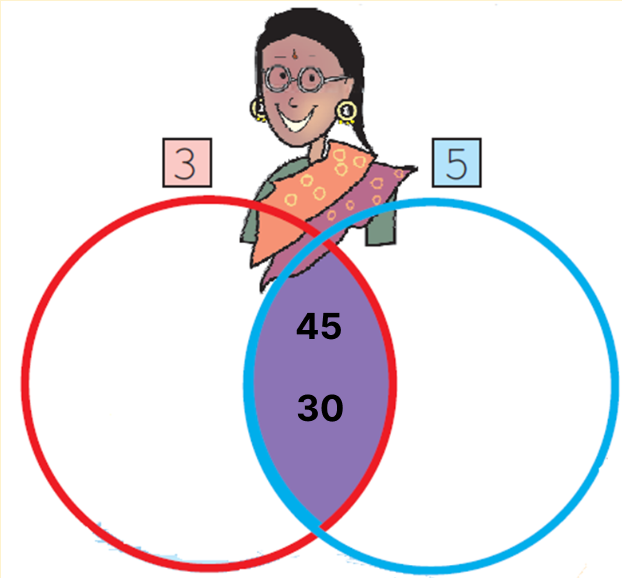
7. Repeat the game using the numbers 2 and 7.
Ans. The multiples of 2 are 2, 4,8,14,16,20, and so on and the multiples of 7 are 7, 14, 21, 35, 49 and so on.
The numbers that are common multiples of 2 and 7 is 14 and so on.
8. Repeat the game by putting the multiples of 4, 6 and 5 in the circles.

Ans.

(i) What common multiples of 5 and 6 did you write in the green part?
Ans. 30 and 60 are the common multiples of 5 and 6.
(ii) What common multiples of 4 and 6 are written in the orange part?
Ans. 12 and 24 are the common multiples of 4 and 6.
(iii) In which coloured part did you write the common multiples of 4, 6 and 5?
Ans. The common multiples of 4, 6 and 5 are written in the grey part.
(iv) What is the smallest common multiple of 4, 6 and 5?
Ans. The smallest common multiple of 4, 6 and 5 is 60.
8. Tamarind seeds.
(i) Sunita took some tamarind (imli) seeds. She made groups of five with them and found that one seed was left over. She tried making groups of six and groups of four. Each time one seed was left over. What is the smallest number of seeds that Sunita had?
Ans. From the question, it is given that,
Sunita is trying to make groups of four, five, and six every time; one seed remains.
So, now we calculate the LCM of 4, 5, and 6 and add 1 to the LCM.
LCM of 4, 5, and 6 is 60
Adding 1 to the LCM, we get 61
Therefore, the smallest number of seeds that Sunita had was 61.
9. More tamarind seeds
Ammini arranges 12 tamarind seeds in the form of different rectangles. Try to make more rectangles like this using 12 tamarind seeds. How many different rectangles can you make?
Ans. We can consider four different rectangles, as shown in the figure below,

(i) If there are 15 tamarind seeds, how many rectangles can you make?
Ans.

10. Colouring the Grid
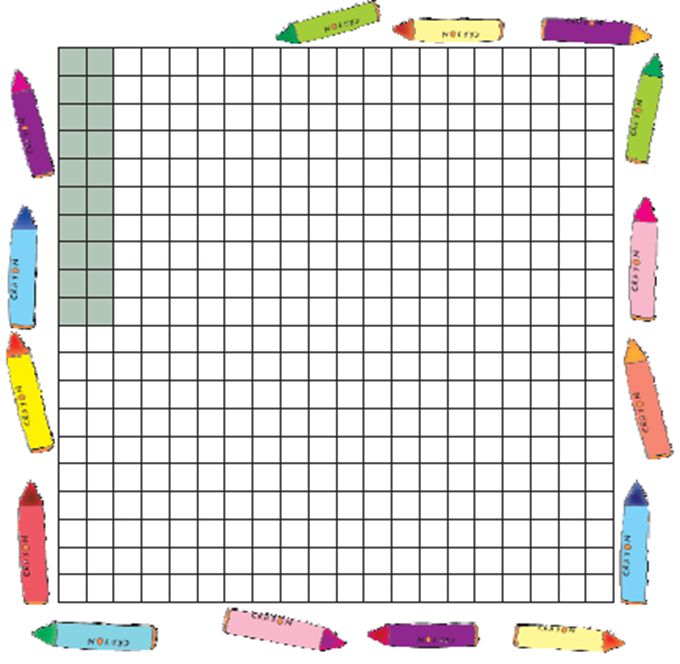
In the grid here, a rectangle made of 20 boxes is drawn.
The width of this rectangle is 2 boxes.
(a) What is its length?
Ans. By observing the rectangle coloured in the grid, we can say that length of the rectangle is 10 boxes.
(b) Colour a rectangle made of 20 boxes in some other way.
Ans.
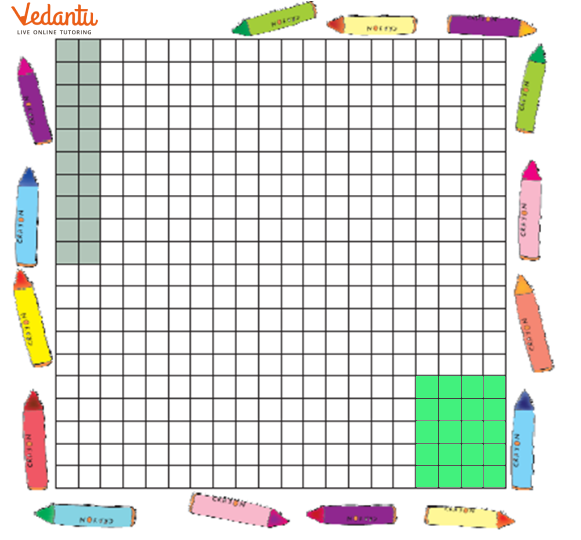
(c) What is the length and width of the rectangle you coloured?
Ans. The length of the rectangle is 5 boxes, and the width of the rectangle is 4 boxes.
(d) In how many ways can you colour a rectangle of 20 boxes? Colour them all in the grid and write the length and width of each rectangle you have coloured.

Ans.
The length and width of rectangle 1 are 5 and 4, respectively.
The length and width of rectangle 2 are 4 and 5, respectively.
The length and width of rectangle 3 are 20 and 1, respectively.
11. There are 18 bangles on the rod. Meena is trying to group them. She can put them in groups of 2, 3, 6, 9 and 18 without any bangle being left.
(a) How many groups will she have if she makes groups of 1 bangle each?
Ans. Meena will have 18 groups if she makes groups of 1 bangle each.
(b) Now complete the table for different numbers of bangles. For each number, see what different groups can be made.
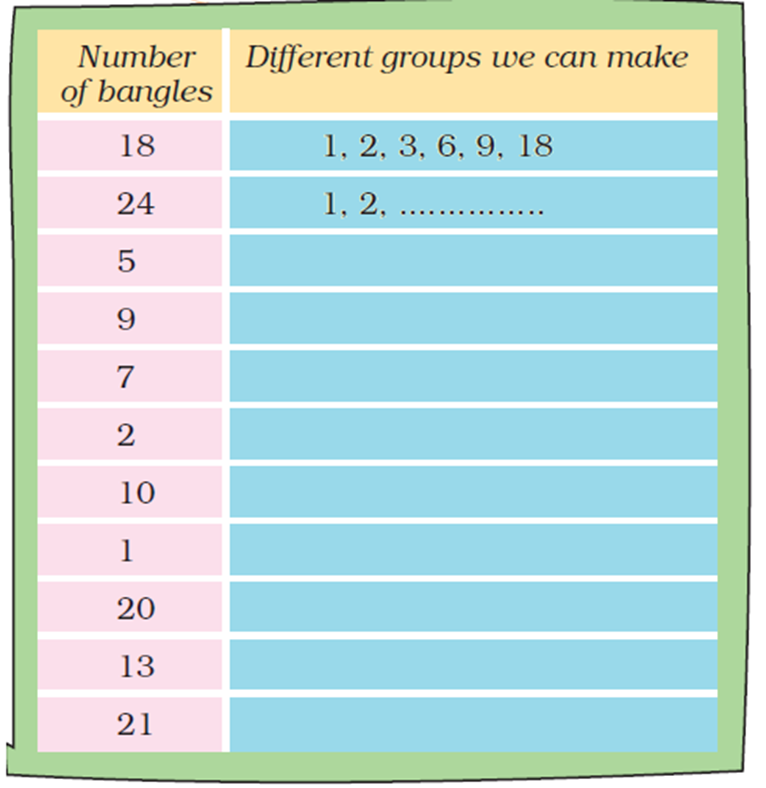
Ans.
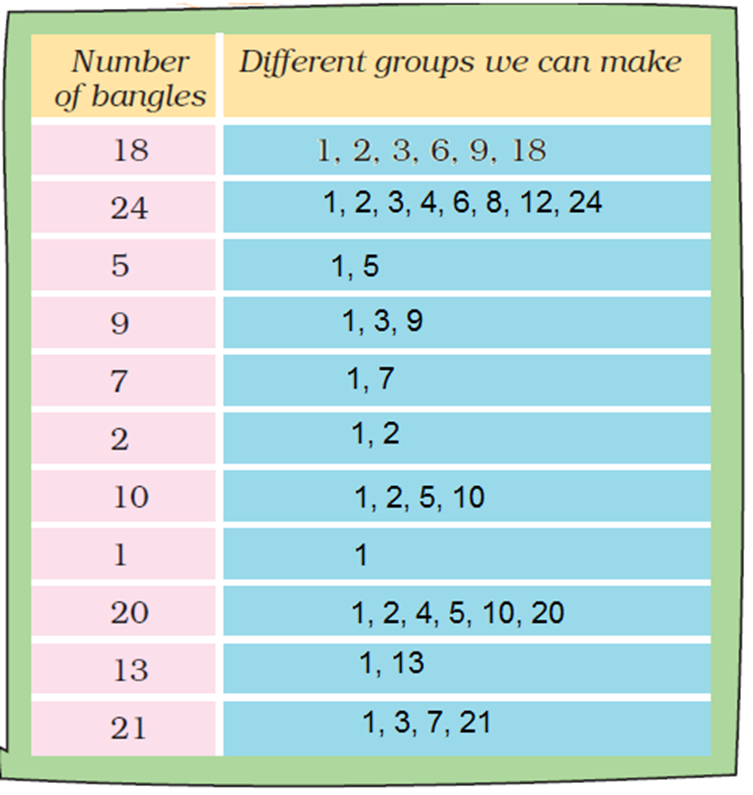
12. Fill the chart
Complete the multiplication chart given here.
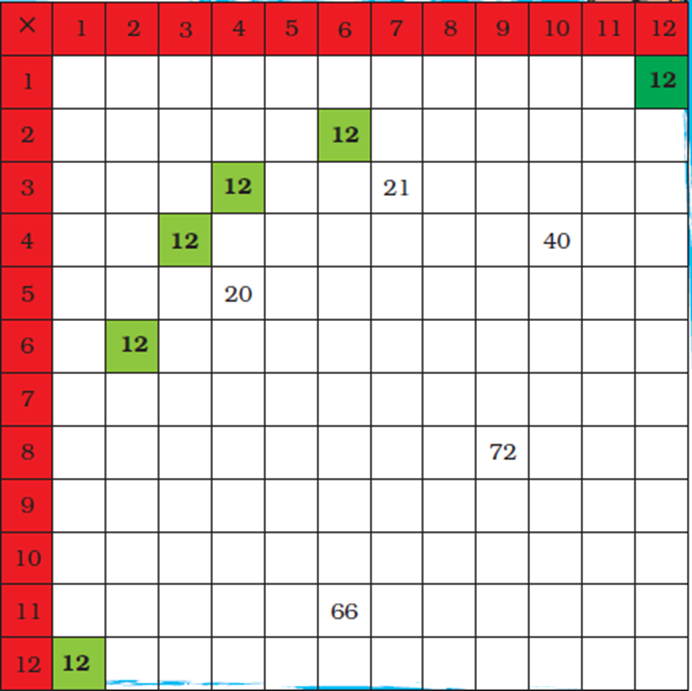
Look at the green boxes in the chart. These show how we can get 12 by multiplying different numbers.
12 = 4 × 3, so 12 is a multiple of both 4 and 3. 12 is also a multiple of 6 and 2, as well as 12 and 1. We say 1, 2, 3, 4, 6, and 12 are factors of 12.
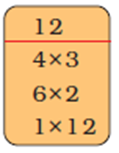
Ans.
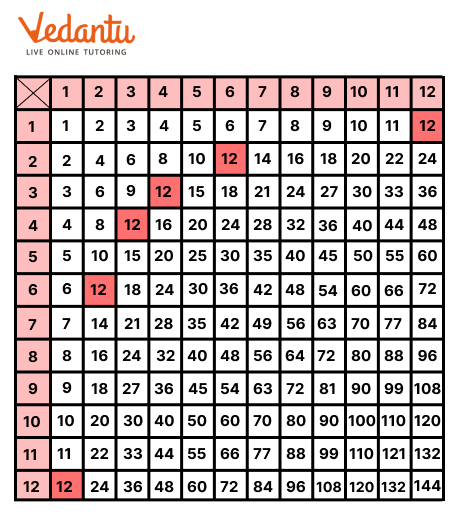

(a) What are the factors of 10? Can you do this from the chart?
Ans. From the chart, factors of 10 are 1, 2, 5 and 10.
(b) What are the factors of 36?
Ans. 1, 2, 3, 4, 6, 9, 12, 18 and 36 are the factors of 36.
(c) Find out all the factors of 36 from the multiplication chart.
Ans. From the multiplication chart, the factors of 36 are 1, 2, 3, 4, 6, and 9.
(d) What is the biggest number for which you can find the factors from this chart?
Ans. From the multiplication chart, 144 is the biggest number for which we can find the factors.
(e) What can you do for numbers bigger than that?
Ans. We will extend the multiplication chart and then complete the chart.
13. Common Factors
(a) Write the factors of 25 in the red circle and the factors of 35 in the blue circle.
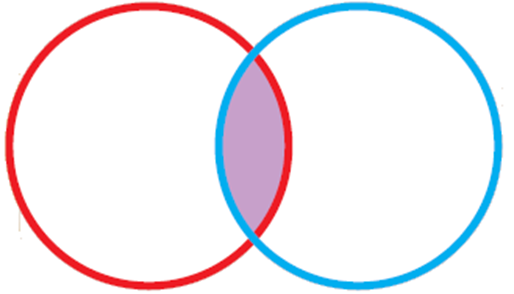
Ans.

(b) Which are the factors of 25 and 35 you have written in the common part (purple) of both circles?
Ans. 5 and 1 are the common factors of 25 and 35 written in the common part (purple).
(c) Now write the factors of 40 in the red circle and 60 in the blue circle.
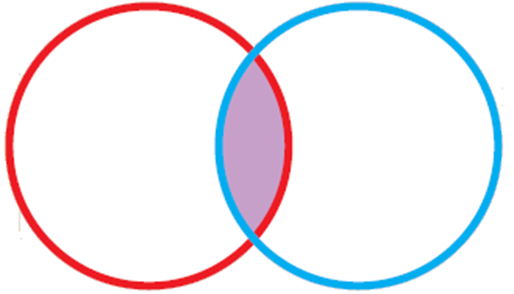
Ans.

(d) What are the factors written in the common (purple) part of the circle? Which is the biggest common factor of 40 and 60?
Ans. The factors written in the common (purple) part of the circle are 1, 2, 4, 5, 10 and 20. 20 is the biggest common factor of 40 and 60.
14. Factor Tree
(a) Look at the factor tree. Now can you make another tree like this?
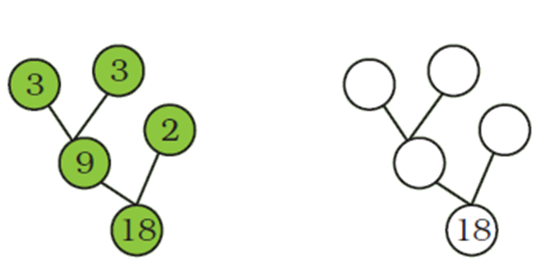
Ans.

(b) In how many ways can you draw a factor tree for 24? Draw three of them below.
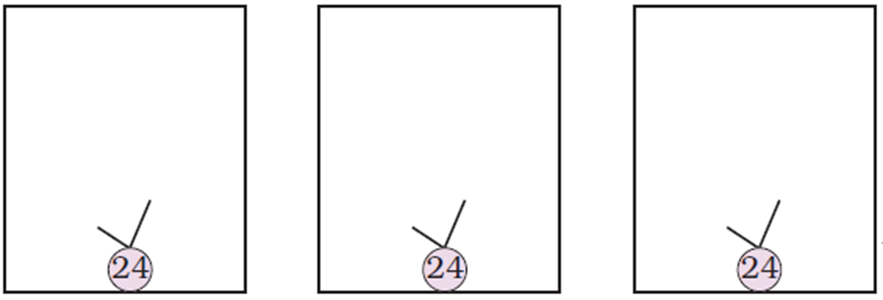
Ans.
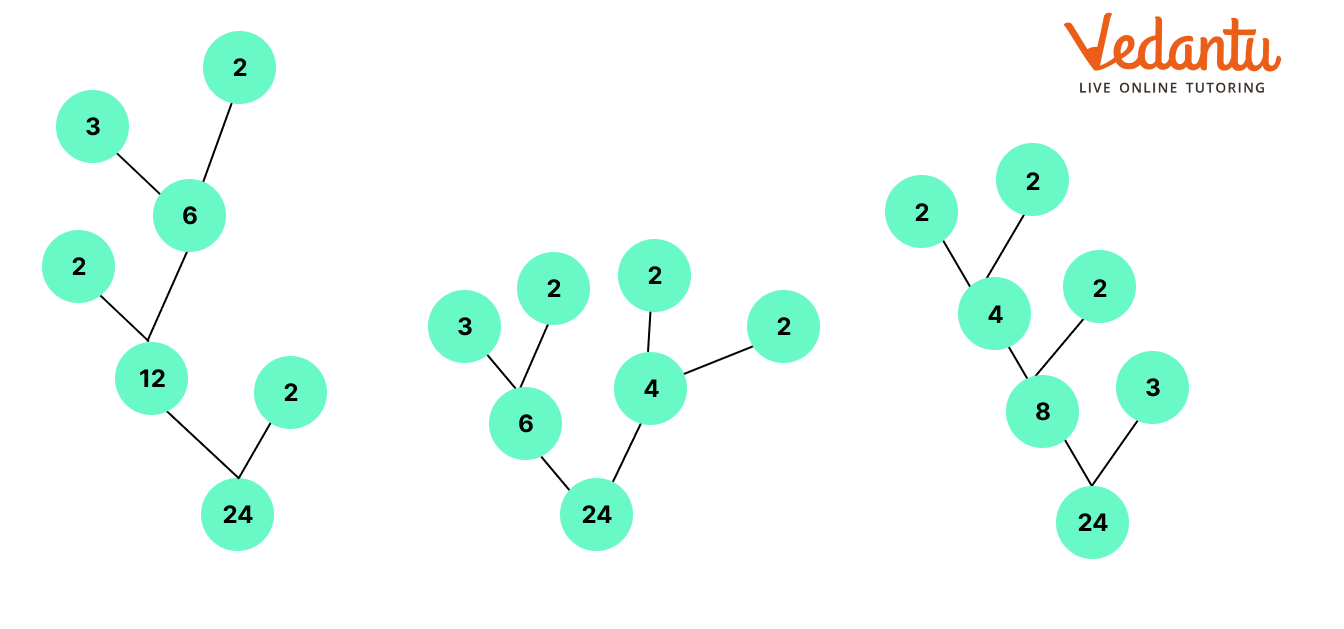
15. Tiling Problems
(i). There is a garden in Anu’s house. In the middle of the garden, there is a path. They decided to tile the path using tiles of lengths 2 feet, 3 feet and 5 feet.
The mason tiled the first row with 2 feet tiles, the second row with 3 feet tiles and the third row with 5 feet tiles. The mason has not cut any of the tiles. Then, what is the shortest length of the path?
Ans. From the question, it is given that the mason tiled the first row with 2 feet tiles, the second row with 3 feet tiles and the third row with 5 feet tiles.
So, now we have to find the LCM of 2, 3 and 5.
The LCM of 2, 3, and 5 is 30.
Therefore, the shortest length of the path is 30 m.
(ii). Manoj has a new house. He has to lay tiles on the floor. The size of the room is 9 feet × 12 feet. In the market, there are three kinds of square tiles: 1 foot × 1 foot, 2 feet × 2 feet and 3 feet × 3 feet. Which size of tile should he buy for his room so that he can lay it without cutting?
Ans. From the question, it is given that the size of the room is 9 feet × 12 feet.
The size of the tiles available in the market are: 1 foot × 1 foot, 2 feet × 2 feet and
3 feet × 3 feet.
Here, 2 is not a factor of the width of the room, i.e. 9 feet, so Manoj cannot lay
2 feet × 2 feet tiles.
1 and 3 are the factors of 3 and 9.
Therefore, Manoj can buy 1 foot × 1 foot and 3 feet × 3 feet so that he can lay it without cutting.
3.
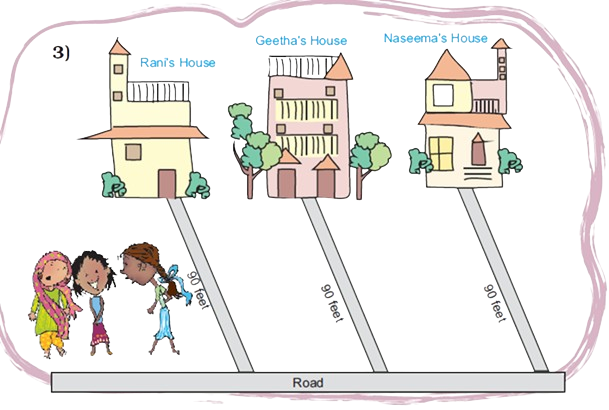
Rani, Geetha and Naseema live near each other. The distance from their house to the road is 90 feet. They decided to tile the path to the road. They all bought tiles of different designs and lengths. Rani bought the shortest tile, Geetha bought the middle-sized one, and Naseema bought the longest one. If they could tile the path without cutting any of the tiles, what is the size of the tiles each has bought? Suggest 3 different solutions. Explain how you get this answer.
Ans. From the question, the distance from their house to the road is 90 feet. Factors of 90 are 1, 2, 3, 5, 6, 9, 10, 15, 18, 30, and 45.
Here are three different solutions:
Solution 1:
Rani: 3 feet
Geetha: 6 feet
Naseema: 9 feet
Explanation:
3, 6, and 9 are all factors of 90.
90 ÷ 3 = 30 tiles for Rani
90 ÷ 6 = 15 tiles for Geetha
90 ÷ 9 = 10 tiles for Naseema
Solution 2:
Rani: 5 feet
Geetha: 10 feet
Naseema: 15 feet
Explanation:
5, 10, and 15 are all factors of 90.
90 ÷ 5 = 18 tiles for Rani
90 ÷ 10 = 9 tiles for Geetha
90 ÷ 15 = 6 tiles for Naseema
Solution 3:
Rani: 6 feet
Geetha: 15 feet
Naseema: 30 feet
Explanation:
6, 15, and 30 are all factors of 90.
90 ÷ 6 = 15 tiles for Rani
90 ÷ 15 = 6 tiles for Geetha
90 ÷ 30 = 3 tiles for Naseema
In each solution, the chosen lengths are factors of 90, making sure that the tiles fit exactly without needing to be cut.
Conclusion
NCERT Solutions for Class 5 Maths Chapter 6 - "Be My Multiple, I'll Be Your Factor" serves as an essential resource for young learners to grasp the foundational concepts of multiplication and factors. This chapter lays the groundwork for more advanced mathematical understanding. The provided solutions offer clear explanations, practical examples, and exercises that help students develop strong mathematical skills. Mastery of multiplication and factors is crucial in mathematics and various real-life scenarios, from solving everyday problems to more complex mathematical operations. These NCERT solutions foster a solid mathematical foundation, empowering students with the knowledge and skills necessary for academic success and practical application in their daily lives.
Other Study Material for CBSE Class 5 Maths Chapter 6
S. No | Important Links for Chapter 6 Be My Multiple, I’ll be Your Factor |
1. | |
2. | Class 5 Be My Multiple, I’ll be Your Factor Important Questions |
Chapter-Specific NCERT Solutions for Class 5 Maths
The chapter-wise NCERT Solutions for Class 5 Maths are given below. Go through these chapter-wise solutions to be thoroughly familiar with the concepts.
S. No | NCERT Solutions Class 5 Maths Chapter-wise List |
1 | |
2 | |
3 | |
4 | |
5 | |
6 | |
7 | |
8 | |
9 | |
10 | |
11 | |
12 | |
13 |
Important Related Links for CBSE Class 5 Maths
S. No | Other Study Materials for Class 5 Maths |
1 | |
2 | |
3 | |
4 | Important Questions for CBSE Class 5 Maths |
5 |
























